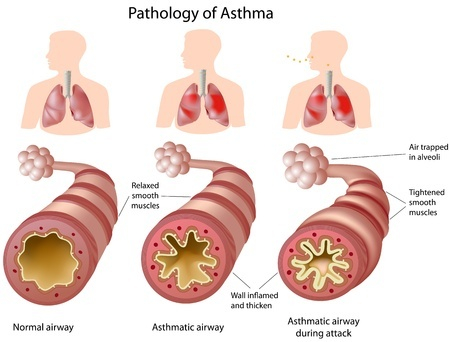WHAT IS ASTHMA?
Asthma is a chronic inflammatory disease of the airways, associated with recurrent, at least partially reversible airway obstruction with intermittent episodes of wheezing and dyspnea. Bronchial hypersensitivity is caused by various stimuli, which affect the vagus nerve and beta adrenergic receptor cells of the airways, leading to bronchial smooth muscle constriction, hypersecretion of mucus, and mucosal edema.
As nurses in corrections, we see a large number of patients affected by asthma. Many have poor asthma control due to their inability to purchase medication, knowledge deficit about their chronic condition or general apathy about their health. Helping the patient achieve and maintain asthma control requires patient education in self-management skills and monitoring the patient’s response to medication to assess control. This may be challenging in the correctional environment, as patient access is not always an easy process. Sometimes, healthcare staff are not on-site twenty-four hours a day, and custody staff must be able to recognize the signs and symptoms of asthma exacerbation. In addition, the correctional environment may contain many of the allergens that the asthma patient should be avoiding! It should be expected that more frequent exacerbations will occur in our environment, and correctional nursing staff must be ready to assess, administer medication to, and monitor their patients with asthma.
SYMPTOMS
The symptoms of asthma include the following:
- a feeling of tightness in the chest
- difficulty in breathing or shortness of breath
- wheezing
- coughing (particularly at night)
TRIGGERS
Asthma triggers vary widely by the individual, and may include:
- tobacco smoke
- infections such as colds, flu, or pneumonia
- exercise
- air pollution and toxins
- weather, especially extreme changes in temperature
- drugs (such as aspirin, NSAID, and beta-blockers)
- food additives (such as MSG)
- emotional stress and anxiety
- singing, laughing, or crying
- smoking, perfumes, or sprays
- acid reflux
- allergens such as food, pollen, mold, dust mites, and pet dander
Quality care for the asthmatic patient includes initial diagnosis and treatment to achieve control, as well as appropriate follow-up care to ensure continued control. The reduction in impairment, including the intensity and frequency of symptoms and the patient’s functional limitations; and a reduction in risk, including medication adverse effects, progressive decline in lung function and the likelihood of future asthma attacks, are two key components in asthma control.
Categorizing Asthma Patients
Asthma patients are categorized into one of four groups: intermittent, persistent-mild, persistent-moderate and persistent-severe. This classification is very important, as it guides the patient’s treatment plan. Any changes to the patient’s condition, such as an increase in exacerbations once admitted to the facility, should be brought to the attention of the provider so that appropriate adjustments to the treatment plan can be made.
Patients classified as Intermittent severity exhibit symptoms no more than two days per week. They will complain of being awakened at night with symptoms no more than twice per month. They will report using short-acting beta agonists for symptom control (excluding its use for prevention of exercised-induced bronchospasm) no more than two days per week. They will report no interference with their normal daily activities as a result of their asthma, and the number of exacerbations requiring oral systemic corticosteroids in the last year is zero to one.
Patients classified as Persistent-Mild severity exhibit symptoms more than two days per week, but not every day. They will report being awakened at night with symptoms three to four times per month. They will report having to use short-acting beta agonists for symptom control (excluding its use for prevention of exercised-induced bronchospasm) more than two days per week, but not more than once per day. They will report only minor limitation in their normal daily activities as a result of their asthma. The number of exacerbations requiring oral systemic corticosteroids in the last year is two or more.
Patients classified as Persistent-Severe severity report having symptoms throughout each day. They report being awakened at night with symptoms every day. They report having to use short-acting beta agonists for symptom control (excluding its use for prevention of exercised-induced bronchospasm) several times each day. They typically experience extreme limitation with their normal daily activities as a result of their asthma. The number of exacerbations requiring oral systemic corticosteroids in the last year is two or more. In the correctional environment, this patient should be closely monitored, perhaps through a special housing assignment.
In our next post, we will discuss medications typically used for asthma patients, and appropriate nursing interventions and patient teaching for the patient with asthma.
Share your experiences caring for a correctional patient with asthma with your colleagues below.
This post is based upon The Correctional Nurse Educator class entitled Asthma I for the Correctional Nurse.
